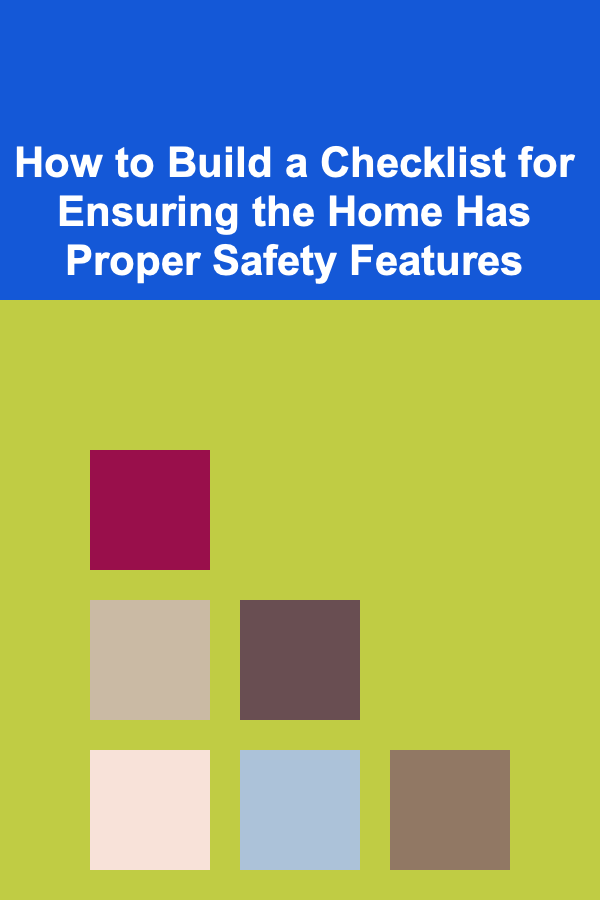
How to Build a Checklist for Ensuring the Home Has Proper Safety Features
ebook include PDF & Audio bundle (Micro Guide)
$12.99$10.99
Limited Time Offer! Order within the next:

Ensuring the safety of your home is crucial for the protection of your family, property, and belongings. A well-structured safety checklist can help you assess potential hazards, prevent accidents, and create a secure living environment. This guide outlines how to build an effective checklist to ensure your home has the proper safety features, covering everything from fire prevention to childproofing and emergency preparedness.
1. Understand Your Home's Unique Safety Needs
Before creating a checklist, it's important to assess the specific needs of your home. Consider the layout, the number of people living there, and any special requirements (e.g., young children, elderly family members, pets, or people with disabilities). Each factor will influence the safety measures needed in different areas of the house.
Key considerations:
- Family composition: Different safety needs for children, elderly, or disabled individuals.
- Location: Homes in areas prone to natural disasters like earthquakes, floods, or hurricanes require specific measures.
- Home layout: Multiple floors, basement, attic, or large backyard may introduce unique risks.
- Security concerns: Neighborhood safety, proximity to emergency services, and crime rates.
2. Fire Safety Features
Fires are among the most common household emergencies, so ensuring that your home has the proper fire safety features is a top priority.
Checklist:
- Smoke Detectors: Install smoke detectors in every room, especially bedrooms, hallways, and the kitchen. Test them monthly and replace batteries twice a year.
- Fire Extinguishers: Place fire extinguishers in easily accessible areas, particularly in the kitchen, near the garage, and on each floor. Ensure that everyone knows how to use them.
- Carbon Monoxide Detectors: Install detectors near sleeping areas and in the basement to protect against carbon monoxide poisoning.
- Fire Escape Plan: Create and practice a fire escape plan with all family members. Ensure everyone knows multiple exit routes, including windows and secondary doors.
- Fire Blanket: Keep a fire blanket in the kitchen or near the fireplace for quickly putting out small fires.
3. Childproofing for Safety
If you have young children, childproofing the home is a must to prevent accidents.
Checklist:
- Sharp Objects: Store sharp objects like knives, scissors, and tools out of children's reach.
- Cabinet Locks: Use childproof locks on cabinets containing cleaning supplies, medicine, and other harmful substances.
- Outlet Covers: Install outlet covers in areas where children can reach electrical outlets.
- Furniture Safety: Anchor heavy furniture, such as bookshelves and dressers, to walls to prevent tipping.
- Corner Protectors: Use soft corner protectors on tables, desks, and countertops to prevent injuries from sharp edges.
- Safety Gates: Install safety gates at the top and bottom of stairs and in doorways to keep children from accessing dangerous areas.
4. Fall Prevention and Stair Safety
Falls are a leading cause of injury in the home, especially in older adults and children. Preventing falls requires attention to potential hazards, especially on stairs.
Checklist:
- Handrails: Ensure that handrails are securely attached to both sides of stairs. For extra safety, consider adding non-slip handrails.
- Non-slip Rugs: Use non-slip pads under rugs and carpets to prevent them from slipping, especially on staircases and entryways.
- Clear Pathways: Keep hallways and staircases free of clutter, cords, and objects that can cause tripping.
- Step Visibility: Ensure that steps are well-lit and clearly visible, especially at night. Use motion-activated lights or install nightlights near stairs.
5. Emergency Preparedness
Being prepared for emergencies is essential for home safety. Natural disasters, medical emergencies, and other crises can strike at any time.
Checklist:
- First Aid Kit: Keep a well-stocked first aid kit in an easily accessible location. Regularly check the kit to ensure that supplies are up-to-date.
- Emergency Contacts: Create a list of emergency contacts (e.g., family members, neighbors, doctors, emergency services) and post it near the phone or in your mobile device.
- Fire Safety Plan: As mentioned earlier, create a fire escape plan, but also ensure that all family members know how to contact emergency services (fire department, police, ambulance) quickly.
- Weather Preparedness: Depending on your location, prepare for potential weather-related emergencies (earthquakes, floods, hurricanes, etc.) by having an emergency kit, backup power sources, and evacuation routes ready.
- Emergency Lighting: Store flashlights, batteries, and candles in strategic places to ensure you have access to light during power outages.
- Backup Communication: Consider having a battery-operated radio or a mobile phone with a power bank to stay informed in case of an emergency.
6. Home Security Features
Home security is a critical component of safety. It protects your family, belongings, and provides peace of mind.
Checklist:
- Locks and Deadbolts: Install sturdy locks and deadbolts on all exterior doors. Consider adding additional security locks on windows.
- Security Cameras: Install security cameras in key areas such as entrances, driveways, and backyards. Consider motion-activated cameras for added protection.
- Alarm System: If possible, install a monitored alarm system that can alert you and the authorities in case of a break-in or emergency.
- Lighting: Use motion-sensor lights around your home's exterior to deter intruders. Ensure that pathways, driveways, and entrances are well-lit at night.
- Neighborhood Watch: Participate in a neighborhood watch program or establish a community alert system to stay informed about security concerns in your area.
7. Electrical and Gas Safety
Electrical and gas-related issues are often overlooked but can lead to serious accidents such as fires or explosions.
Checklist:
- Electrical Wiring: Have a qualified electrician inspect your home's wiring for any signs of wear or damage. Avoid overloading electrical circuits.
- Extension Cords: Never use extension cords as a permanent solution. If you need additional outlets, install them safely to prevent overheating or electrical fires.
- Gas Leaks: Install gas detectors near gas appliances like stoves, water heaters, and furnaces. If you smell gas, evacuate immediately and call the gas company.
- Appliance Maintenance: Regularly check and maintain all household appliances, particularly those that use gas or electricity, such as ovens, dryers, and water heaters.
- Surge Protectors: Use surge protectors for sensitive electronics and appliances to protect them from power surges.
8. Personal Safety Measures
While not always immediately obvious, personal safety within the home is important for reducing the risk of injury or harm.
Checklist:
- Self-defense Tools: If appropriate, consider keeping personal safety tools like pepper spray, a whistle, or a personal alarm.
- Emergency Escape Routes: Ensure that everyone in your household knows where the emergency exits are, including windows or hidden doors.
- Safety Training: Consider enrolling in first aid, CPR, or self-defense classes. Knowing what to do in a medical emergency or personal threat situation can save lives.
9. Pet Safety
Pets are part of the family, and ensuring their safety is just as important.
Checklist:
- Toxic Plants: Remove or keep out of reach plants that are toxic to pets (e.g., lilies, poinsettias, ivy).
- Pet-Proofing: Make sure that small items, chemicals, and hazardous materials are kept out of reach. Consider securing trash cans and food items.
- Outdoor Safety: If your pet spends time outdoors, ensure that the yard is fenced and that there are no escape routes or dangerous areas, such as pools without safety barriers.
- Identification: Ensure your pet has proper identification, such as a collar with an ID tag or a microchip, in case they get lost.
Conclusion
Building a checklist to ensure that your home has proper safety features is an ongoing process. By regularly reviewing and updating the safety features of your home, you can protect yourself, your family, and your belongings from potential risks. Prioritize fire safety, childproofing, fall prevention, emergency preparedness, home security, and overall home maintenance to create a safe environment for everyone living in the house. Keep in mind that safety is about being proactive and vigilant---by taking small steps today, you can significantly reduce the likelihood of future accidents or emergencies.

How to Build a Flexible Riding Schedule for Extra Income
Read More
How to Incorporate Lighting into Your Home's Design Aesthetic
Read More
How to Invest in Sustainable and Ethical Funds
Read More
How to Make Your Own Decorative Pillows and Throws
Read More
How to Refinance Your Mortgage for Better Rates
Read More
How to Save Big: Lowering Homeowner's Insurance Premiums the Smart Way
Read MoreOther Products

How to Build a Flexible Riding Schedule for Extra Income
Read More
How to Incorporate Lighting into Your Home's Design Aesthetic
Read More
How to Invest in Sustainable and Ethical Funds
Read More
How to Make Your Own Decorative Pillows and Throws
Read More
How to Refinance Your Mortgage for Better Rates
Read More